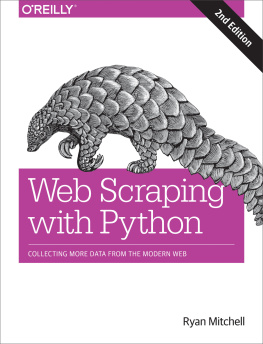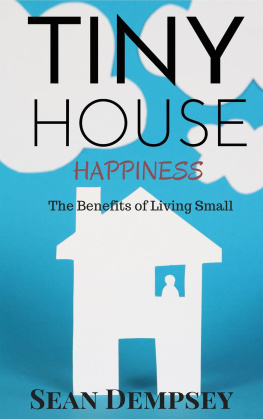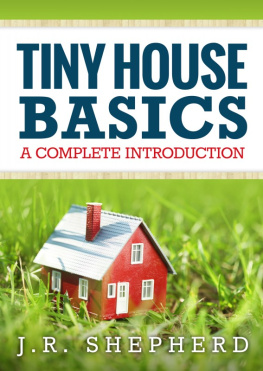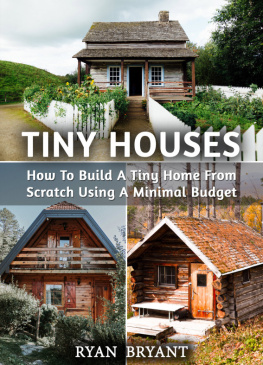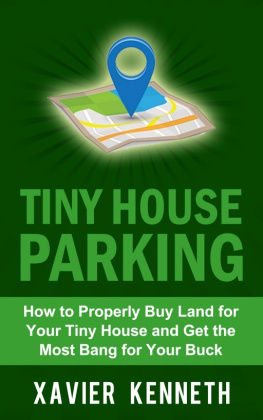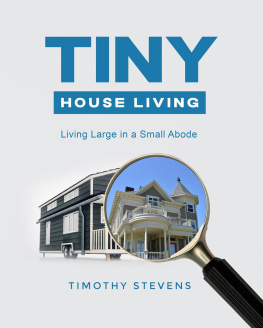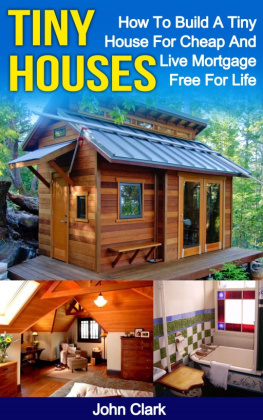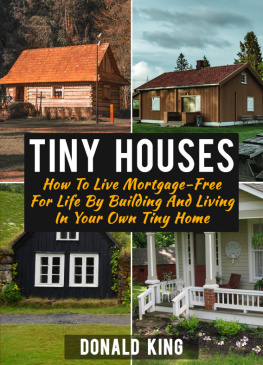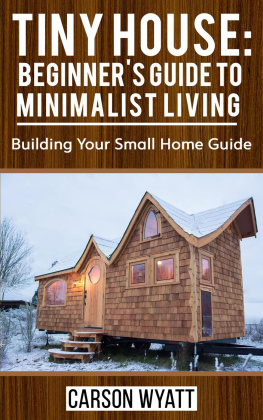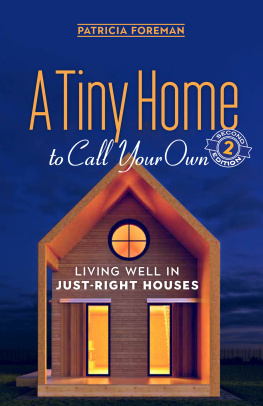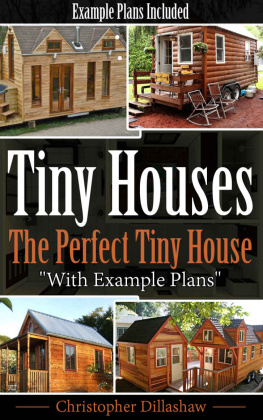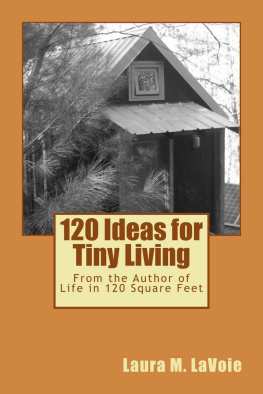
TINY
HOUSE
LIVING
Ideas for Building and Living Well in Less Than 400 Square Feet
Ryan Mitchell

BETTERWAY HOME
CINCINNATI, OHIO
WWW.BETTERWAYBOOKS.COM

Photo courtesy of Mark Walters Photography.
CONTENTS
This chapter examines what a tiny house isand isntand what living tiny means. Its an overview of some of the benefits of downsizing.
There are many reasons people choose to live tiny: they want more free time, they do it to reduce their carbon footprint, they do it to save money, they do it for personal or moral reasons. This chapter delves into the various reasons people choose to live tiny.
Since more and more people are choosing tiny houses, a genuine movement is afoot. This chapter explores the origins and future of the movement.
This chapter examines our culture of consumption and offers useful tips for determining what possessions are really needed for day-to-day life.
This chapter covers everything you need to know to make your decision to live tiny. It covers many of the decisions youll need to make in the planning stages, and tips for navigating the world of building codes and zoning laws.
This chapter is about defining your personal mission statement and designing your tiny life.
This chapter covers the ins and outs of designing a tiny home, including design styles, storage solutions, and options for foundations.
This chapter is meant to inspire. Putting to use what weve learned in the previous chapters, its time to take the leap.

Photo courtesy of Mark Walters Photography.
INTRODUCTION
What is the function of a house? To many people, a house is where you sleep at night and keep your stuff. Naturally, people with this view will want to have the biggest house they can afford so they have room for a lot of stuff. This thinking may explain why in a time when family sizes are shrinking, the size of American homes is growing. Today, the average home is around 2,400 square feet compared to 1,500 square feet in an average home in the 1950s.
But what if you want more from your house than storage? What if you want your house to be a vehicle that helps you live the life of your dreams? It sounds lofty, but thats the goal of the tiny house movement. While many Americans seem to be bent on building the biggest houses they can buy, those participating in the tiny house movement seek to find the smallest living space that can accommodate them. This choice isnt because they live in dense population centers or because they dont have the money for larger homes; rather, it is the pursuit of a lifestyle that seems to be lacking in modern society.
The recent housing and financial collapse of 20082012 shook many of us and left people without jobs, without homes, and without retirement accounts. These harsh economic realities left many people questioning the status quo and seeking livable solutions they could afford. For many, tiny houses are a way to exit the traditional home mortgage, an escape from the rat race, or the means to a comfortable retirement that they previously thought was not possible.
A tiny house is housing with a purpose. We make the decision to live this lifestyle because we have taken a step back, considered the options, and realized its the path for the life we wish to live. The tiny house movement is one in which average citizens are picking up hammers to build their own future. They are saying to the powers that be, We arent playing your game; we choose our own destiny. It is people recognizing that in their short timein this world, they want the freedom to live a life focused on what is important to them instead of a tying themselves to sixty-hour work weeks to maintain large houses full of stuff.
The tiny house lifestyle is one of financial independence, freedom, and ecological responsibility (these houses tread lightly on the earth). For these reasons and many more, people are leaving their McMansions behind and taking up residence in tiny houses to live life tiny.
Living in tiny spaces certainly isnt anything new to humanity; small dwellings are quite the norm for many people who live in cities or areas where real estate costs are high, or those living in situations that necessitate living small. What is interesting is the movement of people who are consciously choosing to live not just small, but tiny. This movement marks a major shift in thinking and living for people across the globe. Despite pressure from the society we live in, people in the tiny house movement are turning to these alternatives and living the life many of us dream of. It is a life that we choose, not one that we are forced into, which is empowering.
Many people will find it ludicrous to live in a tiny house, but those who live in tiny houses find it crazy to live in anything else. While we are a bit fanatical about tiny houses, we realize that living life so small is an extreme. It isnt for everyone, but we hope to at least spark a conversation about the life we live and question how we live it. This book is full of ideas that will help you understand, embrace, and apply the principles of the tiny house movement. Whether you downsize to a 400-square-foot home or simply scale back the amount of stuff you have in your current home, youll learn how to live well with less, which is a freeing idea.

Photo by Christopher Tack, courtesy of Tumbleweed Homes.
THE TINY HOUSE LIFESTYLE
People have tried to define exactly what a tiny house is, and these definitions have brought much debate. But trying to define a tiny house is missing the point. Tiny houses have sparked the imagination because they have taken housing to a place that many people had never even considered. To some, the mere fact that there was an alternative to large homes didnt even enter into the realm of possibility. The movement has built houses that many thought were not possible. It has brought back a design sense that has been lacking in most housing built in the past thirty years. It has carefully evaluated what humans need from the environments in which they livewhich are often not taken into consideration in todays traditionally built homes.
Case Study: Andrew and Crystal Odom
How It All Started
Andrew and Crystal Odoms life in a tiny house started out with a simple questionwhat if?
What if we didnt see wants as wants, but as goals? The Odoms asked themselves this question at the beginning of their marriage, when they were saddled with debt and looking forward to the life that they wanted to build. They reasoned that transforming a want into a goal would motivate them and help them create an action plan to achieve what they wanted.
Their plan was practical and an interesting departure from the culture of conspicuous consumption that Andrew was participating in before his marriage to Crystal. Andrew describes growing up in a culture in which you went to schoolcollege if you were luckywith the goal of getting the highest paying job possible so you could consume in a conspicuous fashion. You consume to show others how successful you are, Andrew said.
Next page

